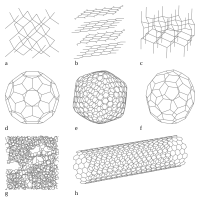
Photo from wikipedia
Herein, water-dispersible carbon nano-onion clusters (CNOCs) with an average hydrodynamic size of ≈90 nm are prepared by simply sonicating candle soot in a mixture of oxidizing acid. The obtained CNOCs… Click to show full abstract
Herein, water-dispersible carbon nano-onion clusters (CNOCs) with an average hydrodynamic size of ≈90 nm are prepared by simply sonicating candle soot in a mixture of oxidizing acid. The obtained CNOCs have high photothermal conversion efficiency (57.5%), excellent aqueous dispersibility (stable in water for more than a year without precipitation), and benign biocompatibility. After polyethylenimine (PEI) and poly(ethylene glycol) (PEG) modification, the resultant CNOCs-PEI-PEG have a high photothermal conversion efficiency (56.5%), and can realize after-wash photothermal cancer cell ablation due to their ultrahigh cellular uptake (21.3 pg/cell), which is highly beneficial for the selective ablation of cancer cells via light-triggered intracellular heat generation. More interestingly, the cellular uptake of CNOCs-PEI-PEG is so high that the internalized nanoagents can be directly observed under a microscope without fluorescent labeling. Besides, in vivo experiments reveal that CNOCs-PEI-PEG can be used for photothermal/photoacoustic dual-modal imaging-guided photothermal therapy after intravenous administration. Furthermore, CNOCs-PEI-PEG can be efficiently cleared from the mouse body within a week, ensuring their excellent long-term biosafety. To the best of the authors' knowledge, the first example of using candle soot as raw material to prepare water-dispersible onion-like carbon nanomaterials for cancer theranostics is represented herein.
Journal Title: Small
Year Published: 2019
Link to full text (if available)
Share on Social Media: Sign Up to like & get
recommendations!